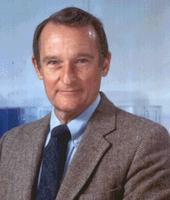










Seymour R. Cray (1925 - 1996), American electronics engineer and computer designer who was the preeminent designer of the large high-speed computers known as supercomputers.
Studies and his Research Career
Cray graduated from the University of Minnesota in 1950 with a bachelor’s degree in electrical engineering. He began his career at Engineering Research Associates (ERA), a leading digital computer company. In 1957, when ERA was taken over in a series of corporate mergers, Cray left to help found Control Data Corp., which became a major computer manufacturer. There Cray led the design of the CDC 1604, one of the first computers to replace vacuum tubes with smaller transistors. He later helped create the CDC 6600, which, at the time of its debut in 1964, was the fastest computer in the world, able to execute three million floating-point operations per second (FLOPS). The CDC 6600 gave rise to the term supercomputer.
In 1972 Cray left Control Data and founded his own firm, Cray Research Inc., with the intention of building the fastest computers in the world. This was largely realized through his innovative design of uniprocessor computers, which allowed simultaneous (parallel) processing. His company’s first supercomputer, the Cray-1, which came out in 1976, could perform 240 million calculations per second. It was used for large-scale scientific applications, such as simulating complex physical phenomena, and was sold to government and university laboratories. Further supercomputers followed, each with increased computing speed. Cray resigned as chairman of his growing firm in 1981 and became an independent contractor to the company, designing ever-faster machines at his laboratory in Chippewa Falls.
Cray was a pioneer of dividing complex computations among multiple processors, a design known as multiprocessing, and his Cray X-MP (1982) was one of the first machines to use multiprocessing. In 1985 the Cray-2 was introduced to the market; this machine, which was cooled by Fluorinert electronic liquid, could perform 1.2 billion calculations per second. The Cray Y-MP, introduced in 1988, was capable of 2.67 billion calculations per second. In 1989 Cray founded the Cray Computer Corporation. However, as microprocessor technology advanced and the demand for supercomputers fell in the post-Cold War era, Cray Computer filed for bankruptcy in 1995. Undaunted, Cray opened another company, SRC Computers, LLC, in August 1996, but he died two months later following an automobile accident.
Cray's legacy lives on in awards like the Seymour Cray Computer Engineering Award, which is sponsored by the IEEE Computer Society.It was established in late 1997. A crystal memento, illuminated certificate, and $10,000 honorarium are awarded to recognize innovative contributions to high performance computing systems that best exemplify the creative spirit demonstrated by Seymour Cray.